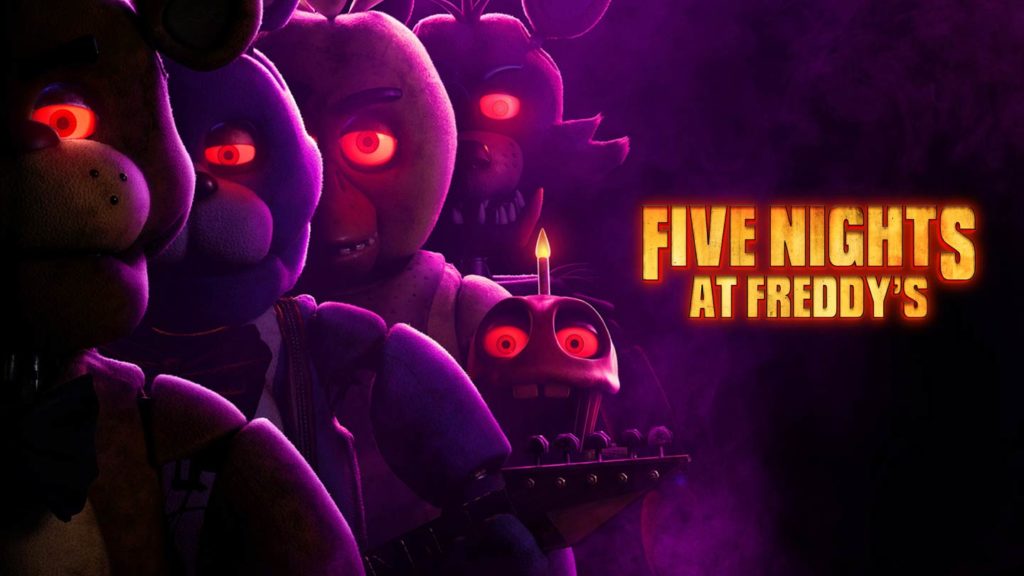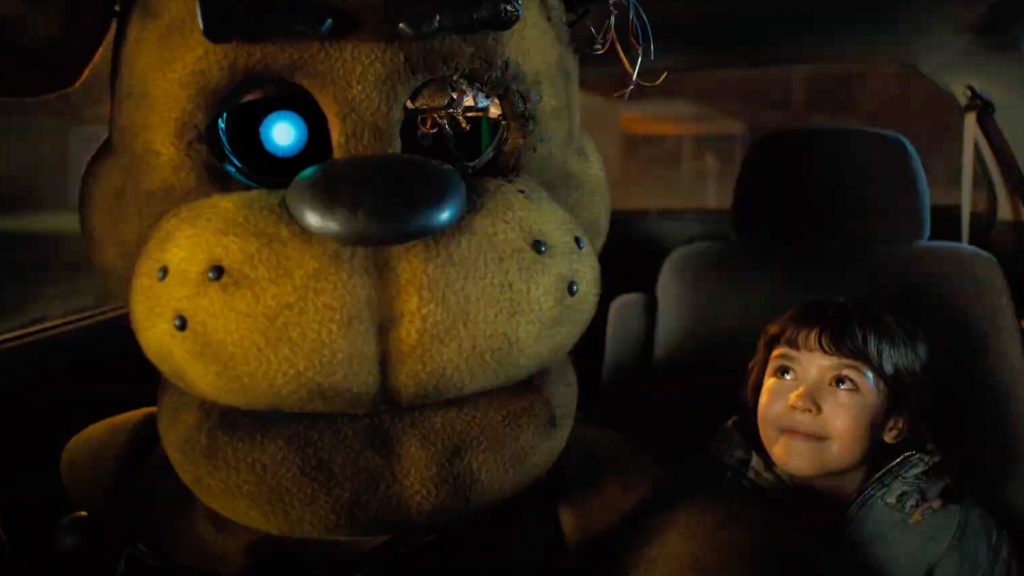In Defense of the Five Nights at Freddy’s Movie
Let me start by saying this will be a biased review. I went and saw this movie on its opening night Friday, October 27, and the next day I went to a Halloween party dressed as Freddy Fazbear himself. When I was growing up, the Five Nights at Freddy’s games (or FNAF for short) was the talk of the lunch table. Groups of 5-10 would be huddled around, looking at one kid’s iPhone 6 as they played, all living in fear of the corny jumpscare animations. FNAF is also known for its cryptic, esoteric lore that has been drip fed through the series’ expansive list of games and books, popularized by YouTube theorists such as MatPat from Game Theory attempting to put all of the puzzle pieces together. I have watched (and in some cases re-watched) many of these videos.
This combination of nostalgia and a strangely deep pile of lore to pull from meant that this movie had a specific target audience of those who are not only familiar with the series, but well-versed in it. Luckily for them, many people from my generation fall into this category, myself included, and for me the movie was amazing. For many on the outside though, it missed the mark to say the least, scoring a 30% on Rotten Tomatoes, and a 33 on Metacritic (both of these scores being based on critic reviews). I’m not the only one who feels the film was treated too harshly, as the user score on both of these sites is around 8/10.
This is a phenomenon that we have continuously seen in the age of adaptations. Uncharted (2022), and The Super Mario Bros. Movie (2023) are two other recent films based on video games that saw sizable disparities between critic and audience scores. Are these user reviews biased due to the fan’s previous experience with the game(s)? Absolutely. But having no familiarity with the franchise doesn’t make the critic view “objective,” and can in fact serve as an equal, or even stronger bias. Often when these movies are made, they are made with the fans in mind (sometimes by fans themselves).
In the case of a typical film, there is a presumption that the critic knows more than the average moviegoer; they’ve studied film and know how to analyze its elements, but these are not typical films. In the case of these movies, the fan’s knowledge of and love for the content outweighs the critic’s knowledge of film in general. The FNAF movie isn’t for fans of film, it’s for fans of FNAF. I, however, am both a critic and a fan, and it would be unfair to chalk up all of the criticism the film received to a simple case of the critics not knowing enough or “just not getting it.” There are definitely flaws in the FNAF movie, but it was still a mostly good experience full of many memorable moments for fans of the franchise to enjoy.
Spoilers for the movie beyond this point:

For the uninitiated, the plot of the movie boils down to this: A troubled security guard, Mike Schmidt (Josh Hutcherson), takes a job at the closed-down “Freddy Fazbear’s Pizza,” to prove to the court that he is financially capable of being the legal guardian of his little sister, Abby (Piper Rubio). While on the job, he realizes that the animatronics in the restaurant, Freddy, Bonnie, Chica, and Foxy, come to life, as they’re possessed by the children who were killed while the restaurant was still open and whose bodies were hidden in the animatronic suits. While these spirits appear outwardly innocent, they seek to turn those who pass through the pizzeria into animatronics, putting Mike and Abby in danger. Mike learns this by talking to the spirits in a series of dream sequences, where he also learns the man who killed the children controlling the animatronics is the same man who kidnapped and murdered his brother when he was a young boy.
These dream sequences are an example of something in the movie that I didn’t really enjoy. Essentially all the time that Mike spends working at Freddy’s, he is asleep in order for him to have these dreams. This means that while the animatronics are moving around and approaching him, Mike is none the wiser. A huge element of the horror in the games was switching between the security cameras and realizing that one of the animatronics isn’t where it was before, and we never actually get to see Mike do this because of the lengthy dreams. Another complaint I had was that some of the characters outside of Mike and Abby felt pretty flat. Particularly Mike’s aunt Jane, who is attempting to take custody of Abby, is completely one-dimensional and comically despicable. This is standard practice for many horror movies, especially for characters that are going to be killed off later on as Jane eventually was. Jane in particular stuck out though due to the fact that her death happened off screen. This felt underwhelming because she was the catalyst behind the plot, as her pursuit of custody is the reason Mike accepted the job at Freddy’s, and was essentially the secondary antagonist of the movie, yet is hastily thrown to the side.
While the secondary antagonist was lackluster, William Afton, the film’s main villain, played by Matthew Lillard, was a delight. As a huge fan of Scream (1996), I’ve been dying to see Lillard as a psycho killer again, and it was definitely worth the wait, even if he was used sparingly. All of his mannerisms and line deliveries, including the ones adapted directly from the games, are captivating and unsettling. Those aren’t the only things that made him a memorable horror villain though, as the design of his spring-lock animatronic suit was a perfect translation from the games, and looked exceptionally creepy. In fact, all of the animatronics looked spectacular, even though none were quite as scary as Afton. The scene where he first emerges from the shadows to confront Mike will be etched into my memory forever. Upon his arrival, my theater erupted in applause and gasps. That theater experience also contributed to my enjoyment of the movie, as I knew I was surrounded by fellow fans. Whenever there was a reference to the games or the fandom, everyone in my theater, including me, ate it up loudly and proudly. I understand this isn’t the ideal theater experience for everyone, and some theaters are rowdier than others, but for me with this movie specifically, it couldn’t have been better.
Apart from their amazing design (courtesy of Jim Henson’s Creature Shop), the animatronics were also portrayed in a unique and memorable way. In the games, the animatronics are never on screen for long or deeply characterized, as the elusiveness and unpredictability is part of the horror. This meant that for the movie, there was a lot of room for interpretation, and I think they took them in a very interesting direction. The film really emphasizes the fact that these killer robots are children on the inside. When they aren’t killing people, they’re having wholesome, childlike fun with Mike and Abby. The juxtaposition allows for a really fun temporary shift in tone, and gives each animatronic moments to stand out individually. It also helps build tension leading up to the climax of the film, as these wholesome scenes come after a long stretch of extreme violence performed by the animatronics. This gives the happy moments unsettling undertones, since the entire time they’re playing nice, you’re left wondering when they will inevitably turn back to sinister.
Overall I loved the FNAF movie. Even if it does have its flaws, those flaws are easy to overlook when you have a deep connection to the source material. I can’t say for certain if a total newbie to the franchise could enjoy it since I’m so far down the rabbit hole that a fresh perspective is impossible for me to imagine. My opinion doesn’t come as a surprise to me, and the response Five Nights at Freddy’s gets from its fans shouldn’t be a surprise to anyone. It’s hard to not like a movie that was made with you in mind.

Five Nights at Freddy’s is in theaters and is streaming now on Peacock

